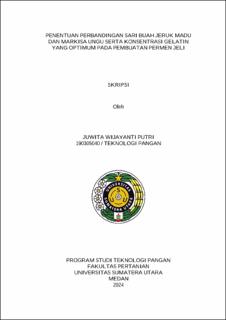| dc.description.abstract | The aim of this research was to find the optimum ratio of honey orange juice and purple passion fruit juice as well as the gelatin concentration in producing jelly candy. This research used a Response Surface Methodology (RSM) randomized using Central Composite Design (CCD) with 2 factors: percentage of honey orange juice in a mixture of honey orange juice and purple passion fruit juice (50% ; 60% ; 70%), and gelatin concentration (11% ; 12% ; 13%). The response tested were moisture content, yield, color index (a, b and °Hue), lightness, pH, water activity (AW), texture profile of hardness, adhesiveness, springiness, cohesiveness, gumminess and chewiness, total vitamin C content, hedonic value of aroma, color, taste, general acceptability and organoleptic value of texture. The results showed a highly significant effect of ratio of honey orange juice and purple passion fruit juice on moisture content, yield, total vitamin C content, lightness, a, b, ⸰Hue, pH, AW, hardness, hedonic value of aroma, taste and general acceptability. Gelatin concentration had a highly significant effect on moisture content, yield, lightness, b, ⸰Hue, pH, AW, hardness, adhesiveness, springiness, cohesiveness, gumminess, chewiness, organoleptic value of texture and hedonic value of general acceptability. Optimal percentage of honey orange juice in the mixture of honey orange juice and purple passion fruit juice as well as gelatin concentration obtained using RSM occurred at percentage of honey orange juice of 62.228% with a gelatin concentration of 12.663% which was the closest to Run 10 with percentage of honey orange juice of 60% and gelatin concentration of 13%. This run was tested for ash content, total sugar content, reducing sugar, total sucrose content, total plate count and antioxidant activity. | en_US |


